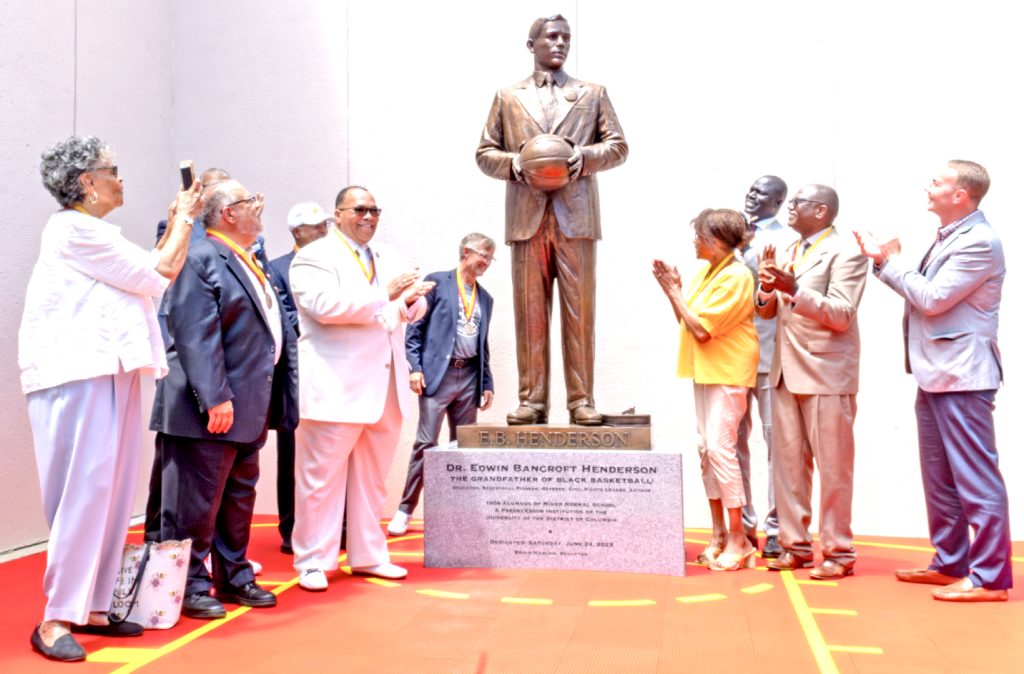by ED HILL Special to the BCSP

HENDERSON STATUE UNVEILED: Patrons applaud as the statue of black basketball and athletics pioneer Edwin B. Henderson was unveiled Saturday at the University of the District of Columbia UDC).
It was only fitting that Edwin Bancroft “E. B.” Henderson be honored with a statue in his likeness.
Regarded as the “Grandfather of Black Basketball,” Henderson was honored this past weekend by dedication of his statue at the University of the District of Columbia (UDC) Edwin Bancroft Henderson Sports Complex on the Van Ness campus.
The ceremony was highlighted by a number of speakers and family members who were in attendance to give testimonials on this giant of a man’s contributions as a noted author, teacher, coach and administrator in the disciplines of physical education and athletics.
A 1904 graduate of the University’s predecessor, Miner College, Henderson would later earn his graduate degree from Harvard and became the first African American man to earn certification to teach physical education in the United States. UDC is the second oldest HBCU in the country.
His storied career which spans over seven decades (1904 until 1977) includes the formation of YMCA programs geared toward getting Blacks to participate and health and physical education in a time of segregation.
He is also credited with the formation of the Eastern Board of Officials – the first of its kind – which gave structure to the sport of organized basketball for blacks.
His efforts were also instrumental in the forming of the Central Intercollegiate Athletic Association (CIAA) and the Washington, D. C. Public Schools Athletic program.
Henderson served as the first head coach at Howard University.
“From a historical perspective, E. B. had the blueprint,” says Barrington D. Scott, a member of the UDC Board of Trustees and a key driving force in the honor.
“He was on a mission to create opportunities for Blacks in sports at a very challenging time. His dedication and vision helped take the participation of Blacks in sports, recreation and education to a new level that changed the landscape forever.”
Scott notes that the efforts were a two-step process.
“We realized that there were no buildings on the UDC campus named after anyone,” explains Scott, an alum of UDC. “They were all numbered. So we pushed for the naming of the athletic complex as a part of Stage One.”
The building was officially renamed after Henderson in February of 2022.
The Stage 2 proposal by Scott featured the statue in Henderson’s honor.
His pioneering efforts as an organizer and activist laid the foundation for athletics in the Black community in the District of Columbia and the United States. And as a public school teacher in Washington, DC, his students included such notable figures as musician Duke Ellington and medical pioneer Dr. Charles R. Drew. Drew was Morgan State’s University’s first athletics director, a position that he used to pay for entry to medical school. He later was on the faculty of Howard’s medical school and an Instructor at the school’s’ Freedman’s Hospital. Henderson co-authored the Spalding “Official Handbook of the Inter-Scholastic Athletic Association of Middle Atlantic States” from 1910-1913. Additionally, he wrote “The from 1910-1913. Additionally, he wrote “The Negro in Sports” in 1939, revised in 1949, and “The Black Athlete” in 1968. His estimated number of published articles is over 3,000.
Henderson was inducted into the Naismith Memorial Basketball Hall of Fame in 2013 and the UDC Athletic Hall of Fame
“We are so very proud of his accomplishments,” said grandson, Edwin Bancroft Henderson II, following the ceremony. “He was long overdue for induction into the Naismith Hall of Fame. A lot has to do with the fact that he never did the things he did for personal reasons It was all based on paving the way for future generations.”
Of all his lofty accomplishments, the young Henderson says one sticks out more than others.”To be the first to create the opportunity for Blacks to learn to play the game with officials and rules is remarkable when you think about it. “That is an important part of his legacy.”

